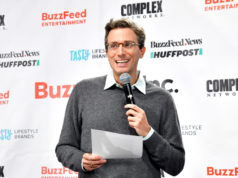
Facebook and Snapchat have overtaken the home pages of Yahoo and Google as the front door to the Internet for hundreds of millions of people. Now, the two rivals are pursuing a much bigger challenge: surpassing television to become the dominant gateway to video.
Tech firms see video as the next frontier of their business. U.S. adults still spend four times as much time watching TV as they do digital video. And U.S. advertisers put seven times as many dollars toward TV ads as they spend online.
The aging of millennials, and Gen Z behind them, naturally could close the gaps. But app makers and video producers will have to make strides in creative and business concepts too.
Whether they stand a chance is being tested in small studios and corners of offices around the world, including in Venice.
There on a recent Friday afternoon, makeup artist Amber Talarico brushed eyeliner onto Kristin Lai. As two digital cameras and a computer broadcast the scene to thousands of Facebook users, Talarico slowly and without commentary dressed Lai to resemble a creepy doll from a horror movie.
The transformation show “Becoming” has drawn almost 200,000 viewers an episode (three seconds counts as a view on the social network; TV’s popular Nielsen ratings require one minute of viewing). “Significant,” Jon Handschin says of the viewership as he turns around on a couch to watch Talarico work.
“I don’t think the numbers have to be millions,” said Handschin, chief creative officer of online media company Moviepilot.
If his guess is right in the long run, Moviepilot and its roster of shows for Facebook’s live-streaming service could turn what it calls Super News into a must-watch channel for movie junkies (the company describes it as the CNN for nerds).
For now, Moviepilot’s Super News division is among the first attempts at designing a media business on Facebook’s or Snapchat’s video systems.
Recurring shows are hitting Facebook from cable companies such as E! and business news provider Cheddar. Individuals are making it central to entertainment start-ups, such as Holly Springs, Ga., resident Brittany Sparacio, who three months ago started plucking pearls from oysters live on Facebook and selling the jewels online.
“We have customers say they will drop their cable and Netflix for this,” Sparacio said in a conversation over Facebook’s chat app. “We go live four or five times a week, and we sustain 3,000 to 4,000 viewers every night.”
Facebook is adding perks that appeal to those who treat its live video platform as a business, announcing Tuesday that it will allow producers to schedule streams in advance.
A Snapchat spokesperson said the Venice company is focused on fostering video channels through Discover, a featured section of its app where old guard media companies such as the Economist and young standouts like BuzzFeed supply articles and videos.
Snapchat has co-invested in two media brands exclusive to Discover. With Vertical Networks, founded by veteran TV executive Elisabeth Murdoch, it’s working on men’s channel Brother and more to come. With Hearst, the part-ESPN and A&E owner, it’s backing lifestyle channel Sweet.
“If Snapchat is this generation’s TV, then the brands that are being built there have a resonance for this generation that’s really powerful,” said Ross Clark, who was hired to run Sweet. “It’s a place where real businesses can be built.”
Clark said he draws inspiration from TV channel Bravo and magazines such as Wallpaper and New York. Consumers have been intrigued. About 15 million viewers a month — a third in the U.S. — tune into Sweet to learn about what’s hot in fashion, food and art. L’Oreal, Apple and Gucci have advertised on the channel.
Investors say they want to see more entrepreneurs spin up video companies that emphasize Facebook, its Instagram image-sharing app, Snapchat and, to a lesser extent, Twitch and Twitter.
The interest follows years of investment in companies anchored on YouTube, some of which sold to media giants including AT&T, RTL Group and Walt Disney.
YouTube has come closer than any video app to surpassing TV. But industry experts say the service is flooded with competition, associated with on-demand viewing and set in its style. Facebook and Snapchat represent uncharted terrain and potentially more lucrative opportunities, so that’s where money is flowing.
Disney already has backed two young media companies from the post-YouTube wave: Naritiv, a marketing company now seeking to develop a consumer brand on Snapchat, and Nom, a live-video and social networking app aimed at those who would watch Food Network all day.
The investments show greater foresight on the part of media companies than during the YouTube wave, meaning they could capture some of the profit that might otherwise go to venture capitalists.
“People understand it’s not a phenomenon or fad,” said Ynon Kreiz, the former chief executive of Maker Studios, a digital video company that sold to Disney in 2014. “This is in broad daylight. No one will be coming at the incumbents from the back door.”
Still, enough uncertainty exists about what approach to take that industry experts think anyone has a shot to succeed.
Among unresolved issues is which service to focus on. Because Snapchat displays videos in full screen with sound, they must attract viewers differently from those appearing on the Facebook news feed, where videos are silent until viewers click on them. Snapchat also lacks live-streaming, and videos disappear from the service after 24 hours. And regardless of where companies start, they might have to expand quickly anyway. Sweet’s Ross said he’s considering the payoff of launching a print magazine or a subscription box filled with featured products.
“Is being one platform only a limit on potential?” said Erin McPherson, a former digital video executive at Yahoo and Maker Studios. “It’s too soon to tell. In my view, the real win ultimately would be developing content that can be used across platforms.”
Early Snapchat investor Jeremy Liew of Lightspeed Venture Partners said he’s looking for start-ups to provide “ambient” video, things like ESPN, daytime talk shows and QVC that air as people move about their homes and jobs. Such programming would stand out from the more mentally intensive video on Netflix, Hulu and Amazon.com.
Hans Tung, managing partner at investment firm GGV Capital, said entrepreneurs could bring “offline” activities to an interactive live broadcast, such as a game show revolving around “Truth or Dare.” Another big opportunity is integrating online shopping and two-way chat into shows in a way never before possible, he said.
Facebook is in the early stages of devising a formal way for publishers to make money from video on its service. Snapchat doesn’t have any revenue offering for third parties, save for partners on Discover with whom it splits ad revenue. That’s a significant concern that’s led Sam Landman, a managing director at Comcast Ventures, to hold off on backing recent media start-ups he’s seen. Snapchat could further complicate strategies by paying upfront to license content rather than splitting ad revenue, the online publication Recode reported Tuesday.
But Landman is optimistic that business plans rooted in a mix of selling ads, subscriptions and syndication rights will eventually make sense.
“We do believe people are willing to pay for content, certainly if they are passionate about the brand,” he said.
Former executives at companies built upon YouTube said success came down to who starred in and made the shows. Nurturing people popular on a certain app and integrating them into productions might be the best way to go.
At Moviepilot, Handschin has been satisfied with Talarico, a nine-year veteran of makeup and special effects, and the rest of the “Becoming” crew.
He chimes in at weekly production meetings, lobbing questions about how they might involve guest stars, be more cost-efficient or be more responsive to viewer comments on the Facebook stream. He passes on lessons, like talk shows don’t seem to draw viewership on Facebook Live, but flying drones and playing games work well.
When Moviepilot launched in 2012, co-founders Handschin and Tobi Bauckhage deliberately tied the firm’s fate to heavy reliance on Facebook. They have no plans to back off. It’s one reason Handschin doesn’t want to study or hire from traditional TV’s top ranks.
“It would corrupt us into something we wouldn’t want to succeed at being,” he said. “I’m looking for the 22-year-old who can create the most astonishing Snapchat story.”
If anything, he worries about his producers leaving to start their own online ventures because he would if he were them. As the hourlong production of “Becoming” wrapped up, producer Sarah van der Watt said Facebook Live does have a unique perk.
“No need for editing,” she said. “We’re just done.”
© 2016 Los Angeles Times under contract with NewsEdge. -.







